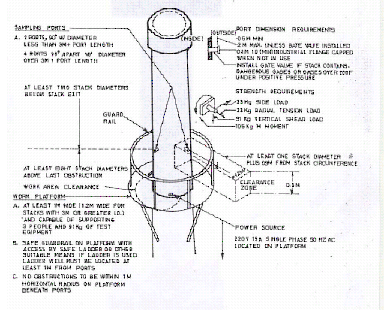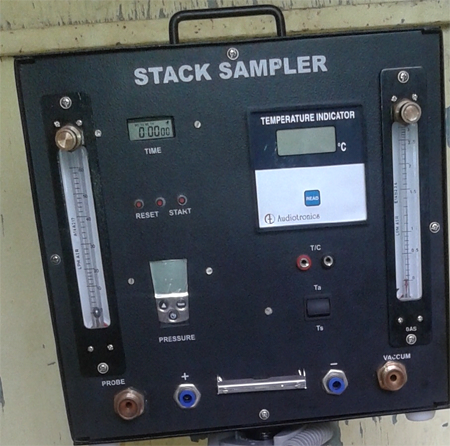Stack Emission Monitoring & Stack Emission Testing
STACK EMISSIONS MONITORING
(Refer Emission Regulations Part III and IS – 11255 Parts 1 to 4)
1. Monitoring Requirements for Industries:
1.1 Central Pollution Control Board’s Emission Regulations Part III emphasizes on the requirement of Stack Emissions and Ambient Air Quality monitoring by the Industrial Units. Further in the General Requirements, therein, it also lay down that the Stack Monitoring shall be done following the frequency given for each industry. The parameters for monitoring in addition to the Pollutants must include the Air Flow rate and the production during the period of sampling. In case of Ambient Air Quality, it shall be done on 24 hour basis on every alternate day and the parameters for monitoring in addition to pollutants shall include data on Wind Speed and direction and Wet and Dry Bulb Temperatures. Emission Regulations also lay down the frequency of Ambient Air and Source Emission monitoring for major industries like Cement, Thermal Power, Integrated Iron & Steel, Fertilizers, Nitric & Sulphuric Acids, Primary Aluminium, Carbon Black, Calcium Carbide & Oil Refineries.
1.2 Further as per Rule 6 (4) of the Prevention and Control of Pollution (Uniform Consent Procedure) Draft Rules, 1999, the State Pollution Control Board shall specify the schedule of monitoring of emissions in the Consent Order. It further lays down that Industries shall build up their own capabilities to carryout monitoring and otherwise services of laboratories recognized by the Central Govt. through Ministry of Environment & Forests or CPCB or SPCB shall be utilized for submission of monitoring reports.
3. Requirement of Sampling Ports:
3.1 It is the responsibility of the Industry to provide Sampling Ports in various stacks (Fuel burning as well as Process) with safe access and platform to facilitate monitoring. The sampling port, if located down stream of a bend or a junction or an expansion or contraction in the stack should be at least 8 times the diameter of stack away from such a disturbance. If located upstream should be at least two diameters away. It should be a standard flanged pipe of internal diameter of 100 mm with a cover flange of 150 mm diameter, extending 50 mm to 200 mm outward from the exterior wall of the stack and mounted 900 mm to 1200 mm above the floor of a stout work platform of minimum 1200 mm width serving at least 1200 mm beyond each port along the circumference.
3.2 Minimum two sampling ports covering two diameters at 900 to each other are required for stacks upto 2 m diameter. Since the length of the Pitot tube shall be restricted, diameters more than 2 m to 4 m shall require four such ports in the stack with an all round platform. The access ladder or stair with a ladder-well or a stair-well and guard railing on the platform should be provided. Electric power supply points of 220 V, 15 A, single phase well earthed one each at Base of Stack and at Platform be provided.
Stack Emission Monitoring & Stack Emission Testing
Stack Emission monitoring is referred to as Stack emission testing, stack emission monitoring, stack sampling, Source Emission Monitoring or Source Testing. It is a process to measure the emission of industrial waste or pollutants emitted into the atmosphere. The pollutants emitted from the stack can be solid, gaseous, liquid organic or inorganic.
What is Stack?
The stack is nothing but chimney which is used to disperse the hot air at a great height, emissions & particulate matters that are emitted from the various types of stacks like boiler, flue gas etc. At these heights, the polluted air disperses in a very large area so that concentrations at the ground are within permissible limits and not harmful for humans, animals and vegetation.
There are several types of flue-gas stack based on fuel injections. Eg. DG set stack, flue gas stack, process stack, furnace stack, boiler stack, chimney etc.

CPCB guidelines for Stack Height
Chimney, Boiler, DG set, DG exhaust pipe etc. Stack height calculation plays an important role in determination of dispersion of pollutants in upper level of air relevant to local building height.
Chimney / Boiler/ Stack Height Calculation Formula
H = h + 0.2 * √KVA
Where,
H = Total height of stack in metre
h = Height of the building in metres where the generator set is installed
KVA = Total generator capacity of the set in KVA
Based on the above formula stack height to be provided can be categorized as follow: This is inline with CPCB guidelines for stack height.
| For Generator Sets | Total Height of stack in metre | |
|---|---|---|
| 50 KVA | Ht. of the building + 1.5 metre | |
| 50-100 KVA | Ht. of the building + 2.0 metre | |
| 100-150 KVA | Ht. of the building + 2.5 metre | |
| 150-200 KVA | Ht. of the building + 3.0 metre | |
| 200-250 KVA | Ht. of the building + 3.5 metre | |
| 250-300 KVA | Ht. of the building + 3.5 metre |
What are the Requirements of Stack Emission Monitoring & Testing?
Perfect Pollucon Services is a stack emission testing company having more than 30 years of experienced experts. They know how to carry out these tasks in an efficient manner.
- To determine the quality and quantity of air pollutants emitted by the source
- To measure the effectiveness of pollutants controller equipment before and after installation
- To measure the effectiveness of pollutants controller equipment for a given condition
- To compare results with emission standards to take required action
- To compare changes in emission with the changes in processes or raw materials
Stack Monitoring Kit

- Stack Monitoring kit used to find gaseous pollutants in emission from a stationary source such as Boiler Chimney, Process outlets, Scrubber outlets Etc by stack emission testing companies.
- It also can be used to determine physical parameters such as exit emission velocity from stack, temperature & flow of Air emission.
- Determination of total particulate matter using isokinetic Sampling Technique.
- Analysis of gaseous contaminants like SO2, SO3, NOx, Cl2, HCL, NH3 etc by using a gas monitoring system.
Stack emission monitoring Equipment is divided into Four Parts
Velocity Measuring Kit
Consist of the inclined manometer, Digital Temperature Indicator, ‘S’ type Pitot tube & thermocouple.
Particulate Sampling Train
Thimble Holder & set of nozzles, condenser, Rotameter, Dry Gas Meter, Time indicator & power source for synchronizing vacuum pump with sampling train.
Multigas Sampling Train
Consists of four glass impingers housed in FRP casing with Rotameter for gaseous sampling.
Vacuum pump
Diaphragm type vacuum pump of suitable capacity.
Stack Emission Monitoring & Testing Procedure
Measurements of these pollutants follow specific predefined stack emission testing procedures and protocols to ensure accurate and representative data of the total amount of pollutants emitted into the atmosphere from a given source in the given time is collected.
It is the most Important that sample collected must truly represent the conditions of flue gas stack. Accurate measurement of Pressure, moisture, humidity, gases, velocity, temperature and Particulate matter is required during Industrial stack monitoring procedure.
It is also required to measure accurately rate of flow gases accurate of weight and volume of samples collected.
Also When a wide range of particles are present in emission flow, there is a possibility that only smaller particles can enter into sampler inlet and larger particles may not enter due to their inertia. So to avoid this situation Calculating isokinetic ratio i.e. Isokinetic Stack Sampling method can be helpful to achieve accurate results in gas boiler emission monitoring.
IsoKinetic Stack Sampling
Stack Emission Measurement Parameters
Collected Sample then tested and analysed in a laboratory for Parameters (Stack Emission Monitoring Parameters) NOx (Oxides of Nitrogen), CO2 (Carbon Dioxide), CO (carbon monoxide), SO2 (sulphur dioxide), VOC (Volatile Organic Compound) etc.
Stack Emission Monitoring Frequency
The frequency for stack monitoring is always directed in Consent to operate for depending on their industry type and plant capacity. Larger plants will have to monitor stack more frequently than small plants. For each industry, there is different frequencies are defined on CPCB website depending on their consent categories. They have covered industries like cement, thermal power, integrated iron and steel, fertilizer, Nitric acid, Sulphuric acid, Primary aluminium, Carbon black, Calcium carbide and Oil Refinery, etc.
What is The Limit of PM Emission For Stack Monitoring?
As per CPCB or Indian standards for Industrial Stack Monitoring the flue gas emission from boiler stack, DG set emissions, the furnace should not exceed the limit for Particulate matter beyond 150 mg/Nm3. However, this limit can vary depending on the industry type.
Stack Monitoring Parameters and Standards / Limits as per CPCB for Boiler & DG Sets Emission
Please refer below table of Stack Monitoring Parameters and Standards / Limits as per CPCB for Boiler & DG Sets Emission:
| SR.No | Stack Monitoring Parameters for Boilers and DG Sets | Stack Monitoring Limits / Standards As per CPCB (in mg/Nm3) |
|---|---|---|
| Particulate Matter (PM) | 150 | |
| Sulphur Dioxide (SO2) | 40 | |
| Oxides of Nitrogen (NOx) | 25 | |
| Total Fluoride (F) | 25 | |
| Mercury (Hg) | 0.2 | |
| Chlorine (Cl) | 15 | |
| Hydrochloric Acid Vapor & Mist (HCl) | 35 | |
| Sulphuric Acid Mist (H2SO4) | 50 | |
| Carbon Monoxide (CO) | 1% | |
| Lead (Pb) | 10 |
Also you can use our online Stack monitoring calculators to calculate Velocity head and Velocity of gaseous flow in Stack.
Recently, in Stack Emission Monitoring below mentioned two technologies introduced to measure online stack emission:
Piezoelectric Monitor – Industrial Stack Monitoring Equipment
In this equipment, particles are electrostatically deposited on to a piezoelectric sensor by stack emission testing companies.
Beta Attenuation Monitor – Industrial Stack Monitoring Equipment
In this equipment, the particulate sample is filtered using a continuous filter tape and the mass of particulates filtered out is determined by measuring its radiations.
Stack Emission Monitoring & Testing Services by our Company
ENVIROTECH RESEARCH PVT LTD, offers Stack emission testing and Source Emission monitoring services to keep a check on industrial waste stream that is released into the atmosphere.
Every industry or manufacturing company has to notify their stack emission levels to the pollution control board. We carry out various tests to determine pollutants concentrations, emission rate or parameter in the Gas Boiler emission monitoring process. We offer to test for benzene testing, toluene testing, heavy metal testing in air, VOC emission monitoring and VOC Testing and analysis.
Copyright © ENVIROTECH RESEARCH PVT. LTD. 2017 All Rights Reserved Designed by : Ameya Computers
